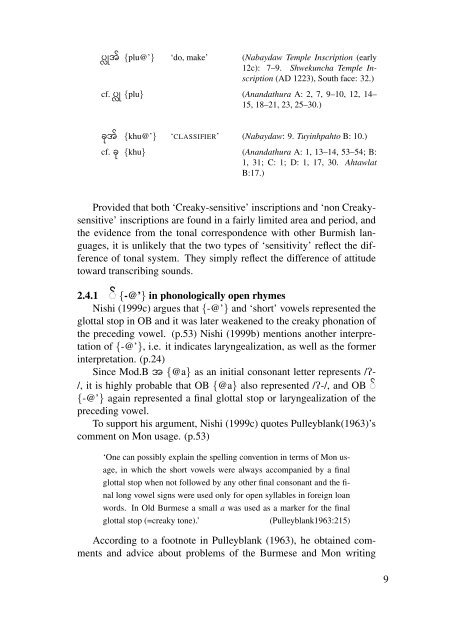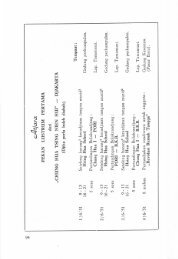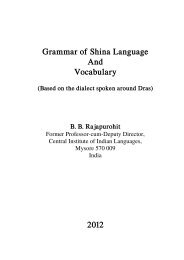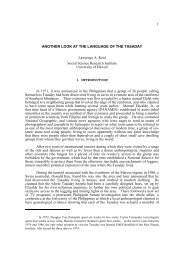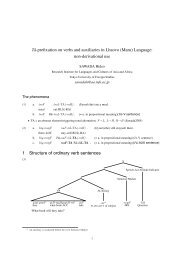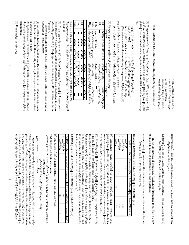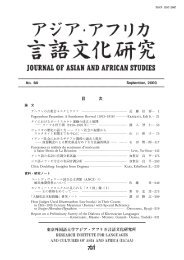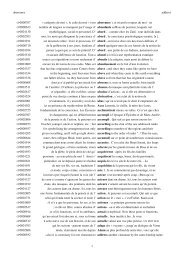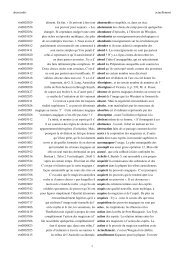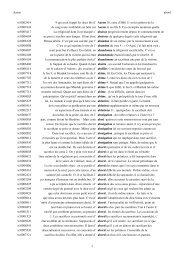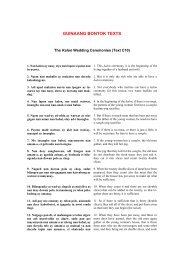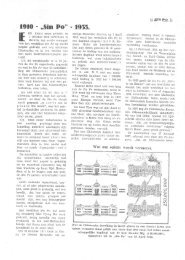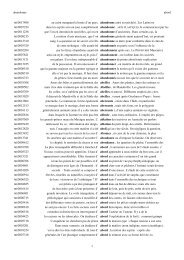Tonal Notation of Indic scripts in Mainland Southeast Asia
Tonal Notation of Indic scripts in Mainland Southeast Asia
Tonal Notation of Indic scripts in Mainland Southeast Asia
You also want an ePaper? Increase the reach of your titles
YUMPU automatically turns print PDFs into web optimized ePapers that Google loves.
pÇáa¸ {plu@’} ‘do, make’ (Nabaydaw Temple Inscription (early<br />
12c): 7–9. Shwekuncha Temple Inscription<br />
(AD 1223), South face: 32.)<br />
cf. pÇá {plu} (Anandathura A: 2, 7, 9–10, 12, 14–<br />
15, 18–21, 23, 25–30.)<br />
Kua¸ {khu@’} ‘CLASSIFIER’ (Nabaydaw: 9. Tuy<strong>in</strong>hpahto B: 10.)<br />
cf. Ku {khu} (Anandathura A: 1, 13–14, 53–54; B:<br />
1, 31; C: 1; D: 1, 17, 30. Ahtawlat<br />
B:17.)<br />
Provided that both ‘Creaky-sensitive’ <strong>in</strong>scriptions and ‘non Creakysensitive’<br />
<strong>in</strong>scriptions are found <strong>in</strong> a fairly limited area and period, and<br />
the evidence from the tonal correspondence with other Burmish languages,<br />
it is unlikely that the two types <strong>of</strong> ‘sensitivity’ reflect the difference<br />
<strong>of</strong> tonal system. They simply reflect the difference <strong>of</strong> attitude<br />
toward transcrib<strong>in</strong>g sounds.<br />
2.4.1 ß`’<br />
{-@’} <strong>in</strong> phonologically open rhymes<br />
Nishi (1999c) argues that {-@’} and ‘short’ vowels represented the<br />
glottal stop <strong>in</strong> OB and it was later weakened to the creaky phonation <strong>of</strong><br />
the preced<strong>in</strong>g vowel. (p.53) Nishi (1999b) mentions another <strong>in</strong>terpretation<br />
<strong>of</strong> {-@’}, i.e. it <strong>in</strong>dicates laryngealization, as well as the former<br />
<strong>in</strong>terpretation. (p.24)<br />
S<strong>in</strong>ce Mod.B a {@a} as an <strong>in</strong>itial consonant letter represents /P-<br />
/, it is highly probable that OB {@a} also represented /P-/, and OB ß`’<br />
{-@’} aga<strong>in</strong> represented a f<strong>in</strong>al glottal stop or laryngealization <strong>of</strong> the<br />
preced<strong>in</strong>g vowel.<br />
To support his argument, Nishi (1999c) quotes Pulleyblank(1963)’s<br />
comment on Mon usage. (p.53)<br />
‘One can possibly expla<strong>in</strong> the spell<strong>in</strong>g convention <strong>in</strong> terms <strong>of</strong> Mon usage,<br />
<strong>in</strong> which the short vowels were always accompanied by a f<strong>in</strong>al<br />
glottal stop when not followed by any other f<strong>in</strong>al consonant and the fi-<br />
nal long vowel signs were used only for open syllables <strong>in</strong> foreign loan<br />
words. In Old Burmese a small a was used as a marker for the f<strong>in</strong>al<br />
glottal stop (=creaky tone).’ (Pulleyblank1963:215)<br />
Accord<strong>in</strong>g to a footnote <strong>in</strong> Pulleyblank (1963), he obta<strong>in</strong>ed comments<br />
and advice about problems <strong>of</strong> the Burmese and Mon writ<strong>in</strong>g<br />
9


